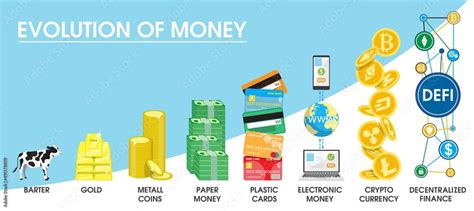In today's rapidly evolving world, the concept of traditional currency is being reimagined as technology continues to advance. As our society navigates through the complexities of finance, a new paradigm is emerging – the rise of digital coins. These groundbreaking alternatives have the potential to reshape the way we perceive and engage with money.
What are digital coins, you might wonder? They are the embodiment of 21st-century innovation, entwining revolutionary technology with the pursuit of new financial possibilities. As the world embraces digitalization, these virtual currencies unlock a realm where transactions are seamlessly conducted with a mere tap of the finger.
Imagine a world where your wealth is stored securely and encrypted within a digital ecosystem, immune to the vulnerabilities of physical currencies. Imagine bypassing the constraints of traditional banking systems, effortlessly exchanging value with anyone across borders and time zones. This is the vision that digital coins bring to life – a vision that transcends the routine, introducing a new era of financial liberation.
The Evolution of Currency: From Barter to Digital Coins

In this section, we will explore the fascinating journey of how the concept of currency has evolved over centuries, transforming from simple barter systems to the emergence of digital coins. Throughout history, mankind has continuously developed new forms of exchange, striving to create a more convenient and efficient medium for transactions.
Early Beginnings: The origins of currency can be traced back to ancient civilizations, where barter systems were prevalent. Individuals would exchange goods and services directly, relying on a mutual agreement of value. This primitive method had its limitations, as it required a double coincidence of wants and was susceptible to inefficiencies and inconsistencies.
The Rise of Precious Metals: As societies grew and trade expanded, the need for a standardized form of currency became evident. Precious metals such as gold and silver emerged as reliable mediums of exchange due to their scarcity, durability, and intrinsic value. They were widely accepted and used as a store of wealth, gradually replacing barter systems.
The Birth of Paper Money: With the advancement of civilization and the rise of banking institutions, the concept of paper money was introduced. Initially, these banknotes represented a specific amount of precious metals held in reserve. Over time, they evolved into fiat currencies, decoupled from physical assets and dependent on the trust and stability of the issuing authority.
The Digital Revolution: In recent decades, the rapid development of technology has revolutionized the concept of currency once again. The emergence of digital coins, such as cryptocurrencies, has introduced a new paradigm of decentralized and secure transactions. These digital assets, utilizing cryptography and distributed ledger technology, offer the potential for greater privacy, transparency, and efficiency in financial transactions.
The Future of Currency: As we embrace the possibilities brought by digital coins, the future of currency is being reimagined. The increasing adoption of digital payment methods, the exploration of central bank digital currencies, and the potential integration of blockchain technology into existing financial systems all point towards a transformation in the way we perceive and utilize currency.
In conclusion, the evolution of currency has witnessed remarkable changes throughout history, from the simplicity of barter to the complexity of digital coins. Each step in this journey has been driven by the human desire for a more seamless and effective means of exchange. As we navigate the ever-expanding landscape of financial technology, it is imperative to understand the past in order to shape the future of currency.
Cryptocurrency: A Game-Changer in the Financial World
In today's ever-evolving digital landscape, a revolutionary concept has emerged that is set to transform the financial realm as we know it. Cryptocurrency, a disruptive technology, has immense potential to reshape traditional monetary systems and redefine the way we conduct financial transactions. This game-changing digital currency opens up new possibilities, offering an alternative form of money that transcends geographical boundaries and operates independently of government control.
Decentralization: | Cryptocurrency breaks away from the centralized control that traditional currencies are subjected to. Instead of being regulated by a central authority, such as a central bank or government, cryptocurrencies operate on a decentralized network known as blockchain. This technology ensures transparency, eliminates the need for intermediaries, and offers a level of security that is unparalleled in traditional financial systems. |
Security and Privacy: | With cryptocurrency, individuals have greater control over their financial transactions and personal information. Transactions conducted using cryptocurrency are encrypted and stored on the blockchain, making them highly secure and virtually tamper-proof. Moreover, while traditional financial systems often require individuals to disclose personal information, cryptocurrency transactions can be conducted with a level of privacy and anonymity that protects users' identities. |
Global Accessibility: | Cryptocurrency opens up a world of financial opportunities for individuals around the globe. Unlike traditional banking systems that may limit access based on geographical location, using cryptocurrencies enables anyone with an internet connection to participate in financial transactions, bridging the gap between the banked and unbanked populations. This inclusive nature of cryptocurrencies has the potential to promote financial empowerment worldwide. |
Financial Innovation: | Cryptocurrency has the power to revolutionize various sectors, including banking, investing, and cross-border transactions. The underlying technology behind cryptocurrencies, blockchain, can streamline processes, reduce costs, and improve efficiency. Smart contracts, a feature of certain cryptocurrencies, allow for automated and secure transactions, eliminating the need for intermediaries and reducing the risk of fraud. This potential for financial innovation has attracted the attention of businesses, investors, and governments alike. |
As the financial world embraces the concept of cryptocurrency, it is becoming increasingly clear that this digital revolution is here to stay. With its decentralized nature, enhanced security and privacy features, global accessibility, and potential for financial innovation, cryptocurrency has the power to reshape the future of currency and usher in a new era of financial empowerment.
Exploring the Fundamentals of Blockchain Technology

In this section, we will delve into the essential concepts and principles behind blockchain technology, an innovative system that has the potential to revolutionize various industries. We will embark on a journey to unravel the underlying mechanisms of this cutting-edge technology and uncover its immense value and implications for the future.
At its core, blockchain technology can be seen as a distributed ledger that enables the secure and transparent recording of digital transactions. It operates on a decentralized network, eliminating the need for a central authority or intermediary, such as banks or governments. Instead, it relies on the collaborative effort of its participants to validate and secure each transaction, ensuring its integrity and immutability.
One of the key features of blockchain technology is its ability to create a chronological chain of interconnected blocks, where each block contains a set of verified transactions. These blocks are then added to the existing chain through a consensus mechanism, such as proof-of-work or proof-of-stake, ensuring the accuracy and consensus of the ledger across the network.
With its inherent transparency and security, blockchain technology has the potential to transform various industries beyond just finance. Its applications extend to supply chain management, healthcare, voting systems, intellectual property protection, and more. By eliminating the need for intermediaries and introducing trustless transactions, blockchain technology provides a secure and efficient platform for these industries to operate.
As we navigate through the fundamentals of blockchain technology, we will explore its key components, including cryptographic techniques, consensus algorithms, smart contracts, and various types of blockchain networks. By understanding these foundational elements, we can gain a deeper appreciation for the transformative power of blockchain technology and its promising future.
Understanding the Advantages and Disadvantages of Bitcoin
In this section, we will delve into the benefits and drawbacks of Bitcoin, a revolutionary digital currency that promises to transform the way we transact and store value in the financial world. By understanding both the advantages and disadvantages of Bitcoin, we can build a comprehensive perspective of its role in the future of currency.
One of the primary advantages of Bitcoin is its decentralized nature. Unlike traditional currencies that are controlled by central banks and governments, Bitcoin operates on a peer-to-peer network that is not controlled by any single entity. This decentralization eliminates the need for intermediaries, such as banks, and allows for greater privacy and autonomy over one's finances. Additionally, the decentralized nature of Bitcoin makes it resistant to censorship and seizure, providing individuals with a level of financial freedom that is unparalleled in the traditional banking system.
Another significant advantage of Bitcoin is its potential for financial inclusivity. Traditional banking systems often exclude individuals who do not have access to a bank account or live in countries with unstable economies. Bitcoin, on the other hand, allows anyone with an internet connection to participate in the global economy, regardless of their location or financial background. This accessibility has the potential to empower individuals in developing countries and create new opportunities for economic growth and prosperity.
However, it is important to acknowledge the drawbacks of Bitcoin as well. One major concern is its volatility. Bitcoin's price can fluctuate dramatically within short periods due to its speculative nature and lack of regulations. This volatility makes it a risky investment for individuals looking for stable stores of value or predictable returns. Additionally, the decentralized nature of Bitcoin also poses challenges in terms of security. With no central authority overseeing transactions, there is an increased risk of fraud, hacking, and theft, which has led to several high-profile incidents in the past.
Furthermore, the scalability of Bitcoin has been a subject of debate among experts. As the number of Bitcoin users and transactions increases, the network has experienced congestion, resulting in slower transaction processing times and higher fees. This scalability issue has hindered Bitcoin's widespread adoption as a mainstream payment method and has sparked the development of alternative cryptocurrencies that aim to address these limitations.
| Pros | Cons |
|---|---|
| Decentralized nature | Volatility |
| Financial inclusivity | Security concerns |
| Privacy and autonomy | Scalability challenges |
The Emergence of Altcoins: Exploring Beyond the Dominance of Bitcoin

In the world of digital currencies, a vibrant new trend has been gaining momentum, pushing beyond the shadow of the widely known Bitcoin. Altcoins, an umbrella term for alternative cryptocurrencies, are emerging as potential game-changers in the realm of virtual money. These revolutionary digital assets, with their unique features and innovative technologies, offer a refreshing perspective on the future of currency.
In contrast to Bitcoin, altcoins refer to a diverse range of cryptocurrency options that exist outside the traditional sphere yet follow similar underlying principles. While Bitcoin undoubtedly paved the way for the decentralization of financial systems, altcoins build upon its foundations to introduce novel concepts and solutions. This expanding array of alternative currencies is challenging the established notions of how transactions should be executed, stored, and validated.
- Variety of Offerings: Altcoins encompass a vast assortment of cryptocurrencies, each designed to fulfill specific purposes and cater to particular user needs. Whether it's promoting anonymity, enhancing transaction speed, or incorporating unique consensus mechanisms, these alternative currencies strive to address existing limitations and provide exciting alternatives to the dominance of Bitcoin.
- Technological Innovation: Altcoins exemplify a breeding ground for technological advancements, leveraging cutting-edge blockchain technologies, smart contracts, and encryption techniques. By introducing novel innovations, such as proof-of-stake algorithms or hybrid consensus models, altcoins break new ground and have the potential to revolutionize the way we perceive and utilize digital currencies.
- Market Competition: The increasing presence of altcoins injects healthy competition into the cryptocurrency market, stimulating innovation and fostering diverse investment opportunities. This proliferation of alternative options prompts investors to consider a broader range of factors when making investment decisions, contributing to a more robust and dynamic ecosystem.
While Bitcoin remains the undisputed leader in the world of cryptocurrencies, the rise of altcoins signifies the maturation of the digital currency market, presenting users with a wealth of choices beyond the conventional. With their distinct features and unwavering commitment to technological progress, altcoins are reshaping the landscapes of finance and commerce, heralding a future where multiple digital currencies coexist and thrive.
Stablecoins: Bridging the Gap Between Cryptocurrency and Conventional Money
In the ever-evolving world of finance, stablecoins have emerged as a revolutionary concept that aims to establish a connection between the volatile realm of cryptocurrencies and the stability offered by traditional fiat currencies. These digital assets, independent of any central authority, have gained prominence for their potential to mitigate the challenges associated with volatility, making them an appealing option for individuals and businesses seeking stability in their transactions.
Stablecoins serve as a bridge, facilitating the seamless transfer of value between the dynamic cryptocurrency market and the more familiar realm of conventional currency. Unlike other cryptocurrencies, stablecoins aim to maintain a steady value by being pegged to an underlying asset or by incorporating algorithms to regulate their supply and demand. This not only ensures stability but also increases their utility as means of exchange, store of value, and units of account.
One common type of stablecoin is the fiat-collateralized stablecoin, which is backed by reserves of traditional currency such as the US dollar or the euro. These stablecoins are designed to maintain a constant value one-to-one ratio with their respective fiat currency, thereby minimizing price volatility. By providing stability, they offer a familiar and reliable medium of exchange for individuals and businesses engaging in digital transactions.
Algorithmic stablecoins, on the other hand, utilize smart contracts and algorithms to automatically adjust the supply and demand of the stablecoin based on predefined rules. This sophisticated mechanism helps in stabilizing the value of the stablecoin by controlling its circulation, ensuring it remains in line with the value of the underlying asset or a certain price index. Algorithmic stablecoins offer a decentralized alternative for those seeking stability without relying on traditional fiat currencies.
With the rise of stablecoins, individuals and businesses are empowered with a new financial tool that bridges the gap between the digital and traditional currency worlds. These stable assets provide stability and reliability, making them an attractive option for individuals, merchants, and financial institutions who wish to embrace the benefits of cryptocurrency without the volatility. As the adoption of stablecoins continues to grow, they have the potential to reshape the future of finance and accelerate the mainstream acceptance of cryptocurrencies.
Central Bank Digital Currencies (CBDCs): Revolutionizing National Economies

In the era of rapidly evolving digital technologies, the emergence of Central Bank Digital Currencies (CBDCs) has sparked significant interest and debate. CBDCs represent a groundbreaking development in the realm of national economies, presenting a potential revolution in the way we transact, store value, and interact with monetary systems. This article explores the essence of CBDCs, their transformative potential, and the implications they hold for the future of currency and economic systems.
The Advent of CBDCs
CBDCs represent the digital iteration of national currencies issued and regulated by central banks. While traditional currencies exist in tangible forms such as cash and coins, CBDCs are entirely digital and operate on blockchain or distributed ledger technologies. These new digital currencies aim to leverage the advantages of blockchain, such as enhanced security, transparency, and efficiency, to streamline financial transactions and augment the existing monetary infrastructure.
Potential Benefits and Features of CBDCs
The introduction of CBDCs brings forth a plethora of potential benefits for national economies. Firstly, CBDCs offer increased financial inclusion, as they enable secure and convenient access to banking services for individuals regardless of their geographical location or socioeconomic status. Moreover, CBDCs can foster more efficient and cost-effective cross-border transactions, minimizing the need for intermediaries and prolonged settlement times.
Furthermore, CBDCs hold the potential to enhance monetary policy effectiveness, as central banks gain real-time visibility into the transactions and financial flows within the economy. This increased visibility allows for more targeted interventions and responsive policy adjustments to stabilize economies and mitigate financial risks.
Challenges and Considerations
However, the implementation of CBDCs also presents several challenges and considerations. One of the primary concerns revolves around data privacy and security, as the digitization of currency requires robust safeguards to protect individuals' personal and financial information. Additionally, central banks must address the potential impact of CBDCs on the existing financial system, including the role of commercial banks and the stability of the overall economy.
In conclusion, Central Bank Digital Currencies (CBDCs) herald a new era in national economies, transforming the way we interact with money and financial systems. While they offer a multitude of potential benefits, the successful implementation of CBDCs necessitates careful consideration of challenges and safeguards to ensure a smooth transition towards the future of currency.
NFTs and the Tokenization of Assets: Unleashing New Possibilities
In today's ever-evolving digital landscape, a new concept has taken center stage - NFTs, or Non-Fungible Tokens. These digital assets have revolutionized the way we perceive ownership and value, bringing forth a paradigm shift in the world of finance and beyond. By leveraging the power of blockchain technology, NFTs enable the tokenization of various assets, tapping into an extraordinary realm of possibilities.
Unlike traditional forms of currency or even cryptocurrencies, NFTs represent unique and indivisible assets that can encompass a wide range of items. From digital artworks, music, and videos to virtual real estate and even tangible assets like real estate, NFTs have opened up a new dimension where anything can be tokenized and traded in a secure and transparent manner.
One of the key advantages of NFTs is the ability to establish immutable ownership and prove authenticity. Each token is embedded with metadata that verifies its uniqueness and origin, providing creators and collectors with an unprecedented level of trust and security. Additionally, NFTs allow for the easy transferability and divisibility of assets, facilitating a global marketplace where individuals can buy, sell, and trade digital goods effortlessly.
The tokenization of assets through NFTs has also unlocked new avenues for creators and artists to monetize their work. By minting their creations as NFTs, creators can retain more control over their intellectual property rights, ensuring that they are properly compensated for their efforts. Moreover, the transparent nature of blockchain technology allows for direct connections between creators and consumers, eliminating unnecessary intermediaries and empowering artists to forge stronger relationships with their fan base.
Furthermore, the emergence of NFTs has ignited a surge in decentralized finance (DeFi) applications, where individuals can utilize their tokenized assets as collateral for loans or investments. This integration of NFTs with the DeFi ecosystem has facilitated the creation of innovative financial instruments, offering individuals the opportunity to unlock the hidden value of their digital assets and explore new realms of investment possibilities.
As we venture deeper into the world of NFTs and the tokenization of assets, it is evident that we are only scratching the surface of its potential. With each passing day, new use cases and applications emerge, pushing the boundaries of what is conceivable in the digital realm. The future holds a world where the ownership and transfer of assets are democratized, empowering individuals to redefine the concepts of value and ownership, and reshaping the landscape of finance and beyond.
The Impact of Cryptocurrency on the Global Economy

In this section, we will explore the profound influence that cryptocurrency has on the worldwide economic landscape. By delving into the realm of digital currency, we discover how it is reshaping traditional financial systems and becoming a driving force in the global economy.
Unleashing a myriad of possibilities, cryptocurrency goes beyond the confines of traditional monetary systems. Its decentralized nature challenges the conventional notion of central authorities and intermediaries. Instead, it empowers individuals and businesses to transact directly, removing barriers and enabling frictionless global transactions.
Furthermore, cryptocurrency promotes financial inclusion by providing access to banking services for the unbanked population. By leveraging blockchain technology, it offers a secure and transparent avenue for individuals in developing economies to partake in the global financial ecosystem, thereby fostering economic growth and reducing poverty.
The impact of cryptocurrency extends beyond individual financial transactions. It shapes macroeconomic factors, including monetary policy and exchange rates. As cryptocurrencies gain wider acceptance, policymakers are grappling with the need to understand and regulate this new form of money, which presents both opportunities and challenges.
Moreover, the emergence of cryptocurrency has disrupted traditional fundraising methods, particularly through Initial Coin Offerings (ICOs). This groundbreaking approach to capital raising has enabled startups and businesses to finance their ventures directly from global investors, bypassing the traditional intermediaries. This newfound accessibility has leveled the playing field and provided opportunities for entrepreneurs around the world.
As cryptocurrency continues to gain momentum, it has sparked innovation in various sectors, such as financial services, supply chain management, and even governance. The integration of blockchain technology into these industries offers efficiency, security, and accountability, ultimately driving productivity and economic growth.
In conclusion, the impact of cryptocurrency on the global economy cannot be underestimated. It revolutionizes financial systems, fosters inclusive economic development, challenges traditional fundraising models, and paves the way for innovation in various industries. Understanding and harnessing the potential of cryptocurrency is crucial for individuals, businesses, and policymakers as we navigate the future of the global economy.
Overcoming Challenges: Regulation and Security Concerns in the Crypto World
The cryptocurrency industry has been rapidly growing, offering innovative solutions and promising opportunities for the future. However, amidst this exciting potential, various challenges arise that must be overcome to ensure the stability and security of this new form of currency.
One of the primary challenges facing the crypto world is the need for effective regulation. As cryptocurrencies operate outside the traditional financial system, they often fall into legal grey areas and face regulatory uncertainty. Establishing clear regulations is crucial to ensure investor protection, prevent fraudulent activities, and promote market transparency. Governments and regulatory bodies worldwide are grappling with the task of striking a balance between fostering innovation and mitigating risks associated with cryptocurrencies.
Another pressing concern in the crypto world is the issue of security. While cryptocurrencies offer enhanced security measures compared to traditional banking systems, they are not invulnerable to cyber threats and hacking attempts. High-profile incidents of exchange breaches and thefts have raised awareness about the importance of robust security measures. Implementing strong encryption protocols, secure digital wallets, and multi-factor authentication are essential steps towards safeguarding users' assets and restoring trust in the crypto ecosystem.
Moreover, the inherent nature of cryptocurrencies, which prioritize decentralization and anonymity, presents challenges in preventing illicit activities such as money laundering and terrorist financing. Striking a balance between privacy and accountability is crucial to address these concerns. Innovative technologies such as blockchain analytics and Know Your Customer (KYC) procedures are being developed to create more transparent and traceable transactions while respecting the privacy of individual users.
Collaborative efforts between industry players, regulatory authorities, and technology experts are key to overcoming these challenges. Establishing global standards for cryptocurrency regulation, investing in advanced security solutions, and promoting awareness among users will contribute to building a more secure and regulated crypto world. As the crypto industry matures, addressing these concerns will be crucial for its continued growth and acceptance as a legitimate alternative to traditional currencies.
FAQ
What is the article "Dream About New Coins: Embracing the Future of Currency" about?
The article "Dream About New Coins: Embracing the Future of Currency" explores the concept of new digital currencies and their potential impact on the future of money.
Why are digital currencies considered the future of currency?
Digital currencies are considered the future of currency due to their potential benefits, such as increased security, faster transactions, lower transaction costs, and the ability to operate on a global scale without relying on traditional banking systems.
What are some examples of new digital currencies?
Examples of new digital currencies include Bitcoin, Ethereum, Ripple, and Litecoin. These cryptocurrencies have gained popularity and acceptance in various industries and are changing the way transactions and financial operations are conducted.



